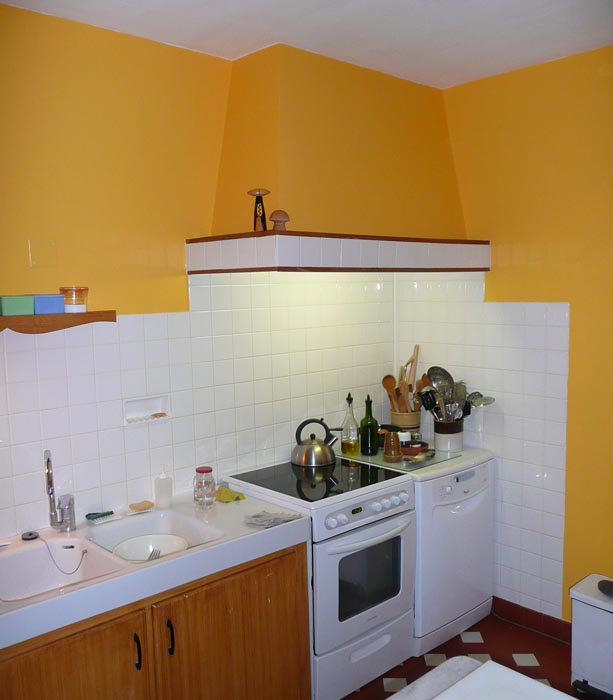We left Saint-Aignan about noon last Saturday for a week in a
gîte rural — a little vacation rental house — on the
Ile d'Oléron. We had never been down there before. Oléron is just south of La Rochelle and Rochefort, and not very far north of Bordeaux, on the French Atlantic coast.
The island is linked to the mainland (
le continent) by a high-rise bridge (known on the Ile d'Oléron as
le viaduc). It's about a four-hour drive from Saint-Aignan and we left at noon. At 3:30 p.m. we drove through Marennes, the last town on the continent, and were ready to cross the bridge and enjoy being on the island. No such luck.
 A plume of black smoke along the highway
A plume of black smoke along the highway
leading to the bridge at Oléron
As we drove out of Marennes, traffic came to a halt. We didn't know why, but we saw a huge plume of dark black smoke off in the distance. Was it a fire? An accident of some other kind? Why were cars just inching ahead? Why didn't we see any firetrucks, ambulances, or other emergency vehicles? We turned on the radio, but we couldn't get any news.
 This was the traffic back-up caused by a protest
This was the traffic back-up caused by a protest
last Saturday at the Ile d'Oléron bridge.
As we sat there in the car for about an hour, wondering what was going on, we would see the plume of smoke thin out and then suddenly thicken up and get blacker and uglier every few minutes. I thought things like tanks of fuel or cans of paint might be exploding in a big fire. Traffic wasn't really moving, and very few cars were passing us heading in the opposite direction, coming off the island.
 This was the commercial fishermen's protest banner. It says:
"Fishermen on strike. Fish not expensive. Diesel fuel too expensive."
This was the commercial fishermen's protest banner. It says:
"Fishermen on strike. Fish not expensive. Diesel fuel too expensive."
When we finally had advanced far enough, we found out what the problem was: a protest. We had heard about France's commercial fishermen,
les marins-pêcheurs, being on strike. The labor action was just starting late in the week. But on Saturday, a group of fishermen had set up a protest site at the foot of the Oléron bridge. They were stopping cars and letting them through just one at a time, and they had built a big bonfire. They were burning old automobile tires. Every time they threw another tire or two on the fire, the smoke blackened and thickened.
 Luckily for us, oysters and clams
Luckily for us, oysters and clams
were still available at markets on the island.
We finally arrived at our rental house about 5:00 p.m., an hour later than we thought. For the whole week we were on the island, the fishing harbors were closed. There was no fish available for sale in the supermarkets or at outdoor markets. For the entire week, we didn't try to leave the island because the demonstration and big traffic back-up continued (but that was okay with us).
French fishermen were protesting the high price of the diesel fuel they need to run their boats. The boats stayed in port all week. The only seafood available was the stuff that is not fished out of the open sea, since boats couldn't go out. No fin fish, no shrimp. We had to make do with oysters and clams. Poor us.
 Last Saturday, as we drove back from Oléron, we stopped in Poitiers for lunch. Nothing really special, just a steak-frites in a chain restaurant called Courtepaille.
Last Saturday, as we drove back from Oléron, we stopped in Poitiers for lunch. Nothing really special, just a steak-frites in a chain restaurant called Courtepaille. Then we got off the autoroute for good at Sainte-Maure-de-Touraine, not too far south of Tours. We drove due east through the villages of Bossée and Manthelan, arriving at Loches. A lot of that drive is through a dense green forest.
Then we got off the autoroute for good at Sainte-Maure-de-Touraine, not too far south of Tours. We drove due east through the villages of Bossée and Manthelan, arriving at Loches. A lot of that drive is through a dense green forest. After Loches, on the way to Saint-Aignan, the countryside turns into rolling fields of farmland with patches of tended woods. Last Saturday, it was emerald green, freshly rained-on, and lush. The sky was full of big puffy clouds with some patches of blue.
After Loches, on the way to Saint-Aignan, the countryside turns into rolling fields of farmland with patches of tended woods. Last Saturday, it was emerald green, freshly rained-on, and lush. The sky was full of big puffy clouds with some patches of blue. Loches isn't far from Saint-Aignan. Someone told me it takes about 20 minutes to drive it, but you have to really put your foot down to make that kind of time. Better to slow down and enjoy the sights — little villages of stone houses with flower boxes of geraniums, the picturesque château de Montrésor, tall church steeples, and birds feeding in the fields. And feel good about being back in Touraine.
Loches isn't far from Saint-Aignan. Someone told me it takes about 20 minutes to drive it, but you have to really put your foot down to make that kind of time. Better to slow down and enjoy the sights — little villages of stone houses with flower boxes of geraniums, the picturesque château de Montrésor, tall church steeples, and birds feeding in the fields. And feel good about being back in Touraine.















































